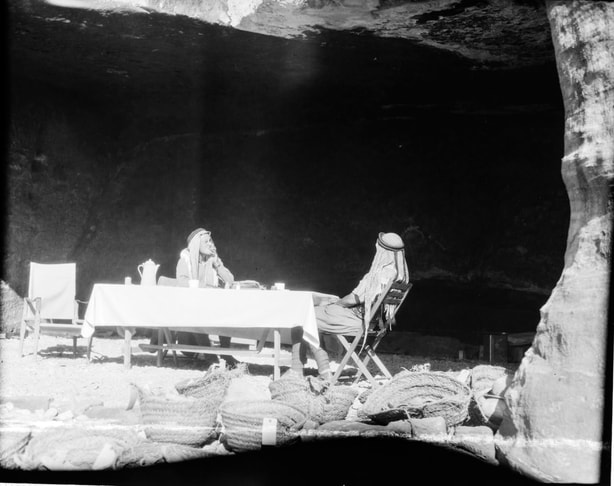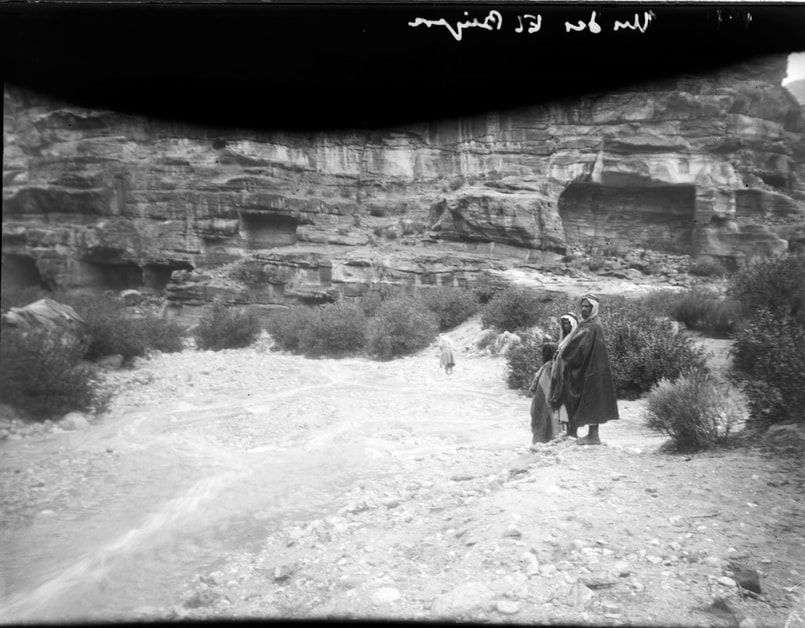|
[by Agnes Conway and George Horsfield] Dr. Nielsen spent the day working at the Sanctuaries on El Habis, and felt that he had discovered enough in one morning to justify his journey. This complex of cult monuments, all orientated to the west, seem to him to be the earliest Arabian sanctuaries, circa the 2nd millennium B.C. He thinks that the bulls heads on the so-called “pulpit” and the cone shaped top, somewhat resembling a coil, of snakes, are of human workmanship, though much weathered. (He turned this down afterwards). A.E.C. spent the morning and afternoon exploring the Wady El Tughra. Below El Habis, S of the sanctuaries, she found what might almost be called a cemetery of shaft graves, some leading into large tomb chambers below. All were of solid construction and considerable depth, but the roofs in all cases had gone and the contents were rifled. One shaft grave had 3 small detached obelisks near it, and the holes for the bases stood at the head of the grave 1. The graves on the opposite side of the Wady under El Bijara are much later. Two sumptuous Nabataean temple graves have later partition walls of large stones, regularly built (prob. Bedouin?). One large tomb with a niche for a single grave has only a small hole knocked out of the slab and might be worth exploring for its contents. Following the Wady southwards a large irregular lump of sandstone in the middle (the Kegelberg) is also a collection of shaft graves, and further on on the western side are a few shaft graves in front of some of the largest Hellenistic tombs. The green plateau between the Wady and the W. face of El Biijara is a mass of large worked stones, probably Greco-Roman and looked to her like remains of the town. Where the Wady en Mer runs into the Wady el Tughra are a few rock-hewn caves, almost entirely silted up with sand, which might be worth excavation. G. H. started digging in mound S.W. Zubb Pharoon [sic], on the part that lies above Dalmans [sic] “Byzantine” Wall. It is covered with Byzantine pottery but the steps cut in the side of the mound produced very little. The mound in this part is composed of sand and a certain amount of burnt debris, probably from wood fires, but contained no charcoal. The sand is loose and the digging had to be done with caution for fear of a land slide. In the afternoon moved further South, where the debris is deep, and higher up the mound, which is apparently surmounted by a fortified wall which is not shown in Dalman’s plan. It breaks out from the Byzantine wall then turns until it meets the rock, with a shaft tomb. Below this lies another with slabs in place, one being broken so that you can peer in. It is partially filled with debris, and seems to have a chamber on either side. The pottery finds were poor, but a deep cutting may be interesting. The evidence so far obtained points to the wall being pre-Byzantine, as it is buried in debris of this period. Today the Camp was finished. It is situated in the Wadi Deir, in caves on both sides. In the West is the cookhouse, Living Room, W.C. and stables, and beyond a Bathroom. Dr Nielsen and Miss Conway are accommodated in tents. On the East is the Guardroom, which is also used as a Store House; adjoining is a small cave for G.H. and next door is the Guest Room. It is fairly compact, and the guard room covers all points of approach.
Many deficiencies have been discovered in the equipment, which was reduced as much as possible. These are being taken in hand, and Thos. Cook and Son’s camp, in the person of the Manager, has been most helpful. It is impossible to buy anything at Elgi, except the poorest things. No vegetables are obtainable. Milk is procurable. Chickens and sheep have to be got from the Arabs some miles away. Arrangements are beginning to work, so that all the attention of the Expedition may be given to the work of exploration. __ [Footnote]: 1. These are probably not holes for obelisks, but the ordinary ones for offerings. Mr Horsfield excavated these shaft graves later on. Reference: [unsigned, but by Agnes Conway and George Horsfield] 1929 (transcribed by A. Thornton). Petra Exploration Fund Diary. "Business Papers to be Kept", Horsfield Collection Box 8, UCL Institute of Archaeology, 26 March: 6-9. [probably by Agnes Conway and] by George Horsfield
A.E.C. took Mr Horsfield to see 3 silted up caves above the Wady Farasa, which may be worth digging at to see if they are early. He also investigated Dr Nielsen’s El Habis sanctuaries and climbed a mountain at the back of Wady Ed Deir and our Camp, to copy a new Nabataean inscription found by his Circassian Inspector, Ali, at the very top. Dr. Canaan covered a large area identifying place-names. A.E.C. and Dr. Nielsen went up the Ma’aisera again. She worked through Dalman’s Sanctuary No. III, which seems the most complete and interesting of them all, and was delighted with the long terrace on the edge of the Ma’aisera El Garbiyah which looks like the esplanade of a great Italian city. March 30. G. Horsfield No digging was done as the workmen failed to turn up. Saw the Sheikh Bashir and it seems to be his doing, as he wants to collect his share of the plunder. I informed him that I was indifferent whether they came or not. Explored the mountain on the W side of Wadi Deir over the Camp with Ali, and copied in part the Nabataean inscription which Ali found the other day. My transcription was poor and the inscription deteriorated, so Dr Nielsen was not able to make it out. The excavators from Doura (on the Euphrates), Mr and Mrs Hopkins and Mr Johnstone, arrived about 7.30 p.m. in search of a cave for the night with a letter from Alright [sic] of the American School. Gave them a table and a corner of the living area – which is a nuisance for the rest of the party, though they in no way interfere with us except by their presence. We have decided to clear out another cave on the other side, which will do to put up chance visitors who will have the benefit of the guards and complete independence. Reference: [probably Conway, A. and] Horsfield, G. 1929. Petra Exploration Fund Diary. "Business Papers to be Kept", Horsfield Collection Box 8, UCL Institute of Archaeology, 30 March: 15-16. [by Agnes Conway] A. C. No dig today as it poured with rain and Mr. Horsfield sorted pots, and A.E.C. welcomed the chance of reading. At lunch-time there was a shout of water in the Wadi Musa, and the whole camp rushed to see it pouring into the Siyagh. It was, however, coming from the Metaha and not from the Sik at that time; so Mr H. and A.E.C. went to examine the large buildings under El Hubta. The enormous façade next but one N. of the Tomb of the Urn has only 2 small but perfectly squared or tooled rooms, one of which seemed to ring hollow in the middle of the floor and may be worth clearing out. The next two at right angles to each other, have no facades and may be houses. The Corinthian Tomb has capitals almost Byzantine, combined with triglyphs and dentals of yellow stone painted with stripes of black. It was impossible to tell whether the inserted stone of the low arches on the left was plastered or not. Inside the Palace Tomb the arrangement of 4 bases for sarcophagi 1, on a high shelf in a niche, was odd and unique in Petra. The colour of this ceiling and the neighbouring one on the left was superb in the greyish light; a fantastic palette of blood red, orange, pink, grey, pale mauve, and silver, set off by great black splotches from the Bedouin fires. As soon as the sun shone the colour paled. This English day of thunderclouds, and snatches of deep blue sky brought out all the colour of the rocks and intensified the green. A blinding hail storm was difficult to battle against on the way home. We jumped the Wady Musa and got to camp a few minutes before the Deir Wady became a raging torrent, cutting off the 2 sides of the camp from each other, and threatening the tents, around which trenches had to be dug at once. Before supper the stream was dry again. __ [Footnote] 1. The same seen later near right [? In pencil] of Tomb of Urn Reference: Conway, A. 1929 (transcribed by A. Thornton). Petra Exploration Fund Diary. "Business Papers to be Kept", Horsfield Collection Box 8, UCL Institute of Archaeology, 21 April: 48-49. |
Categories
All
Archives |


 RSS Feed
RSS Feed